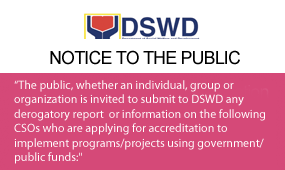
The Department of Social Welfare and Development (DSWD) Field Office Caraga turned over recently a tribal center to the Manobo community in Barangay Sta. Maria, Trento municipality, Agusan del Sur.
DSWD Caraga Regional Director Mari-Flor A. Dollaga officially handed over the KALAHI-CIDSS PAMANA IP-CDD sub-project to Trento Municipal Mayor William Calvez, Sta. Maria barangay chairperson William Martinez, and to the tribal community members.
“Dako ang akong kalipay kay nagkatapok kita tanan karun. Kitang tanan dunay kalabutan niini — gikan sa DSWD Field Office Caraga padulong sa local government unit, sa barangay, ug sa komunidad — kitang tanan dunay partisipasyon, (It is my great joy that we are gathered here today. We are all part of this — from the DSWD Field Office Caraga to the local government unit, the barangay, and the community – we have participation)” Director Dollaga said, adding that it was her first time to attend an inauguration ceremony of a KALAHI-CIDSS sub-project.
KALAHI-CIDSS, otherwise known as the Kapit-Bisig Laban sa Kahirapan-Comprehensive and Integrated Delivery of Social Services, is one of the poverty alleviation programs of the national government being implemented by the Department of Social Welfare and Development (DSWD). It uses the community-driven development (CDD) approach, a globally recognized strategy for achieving service delivery, poverty reduction, and good governance outcomes.
“Partisipasyon. Kini ang isa sa mga prinsipyo nga gipatuman sa Community-Driven Development nga gigamit sa programa. Kini nga tinuod nga project sa KALAHI-CIDSS. Ang tumong gyud nga proyekto sa KALAHI-CIDSS is community involvement and empowerment (Participation. This is one of the principles in the Community-Driven Development approach used by the program. This is the true project of KALAHI-CIDSS, which aims to achieve community involvement and empowerment,” Director Dollaga added.
The Php3.5-million tribal center was completed on October 5, 2022, and is expected to benefit 1,788 Manobos in the said barangay. The building has two restrooms, an office, kitchen, water tank, tables, chairs, among other amenities.
“Very lucky ang Sta. Maria nga naa si RD kay it’s very rare nga naay regional director (RD) nga maka-attend sa ingani tungod sa ilang ka busy. Dako kaayo natong kalipay nga naa na ning tribal center. Kung naa moy mga meeting or activities mao ni inyong magamit, mao nga dapat inyo ning i-maintain nga dili ni mangaguba (Barangay Sta. Maria is very lucky that RD is here since it is very rare for regional directors to attend this kind of events due to their busy schedules. We are very happy for this tribal center. You can have your meetings here; thus you need to maintain this so that it will not be damaged,” Trento Municipal Mayor William G. Calve told the community.
“Sa tanan indigenous people diri sa atong munisipyo, kinahanglan maghiusa ta. Dili ko gusto nga sige mo’g away-away. Unsaon sa gobyerno pag tabang sa inyoha kung kamo mismo mag bingkil-bingkil (All the indigenous people in this municipality should be united. I don’t want that there are conflicts amongst you. How will the government extend its help when you yourselves are fighting),” Mayor Calve reminded the IPs.
For tribal chieftain Bae Batingaw Cherlyn A. Espiel, the tribal center is more than just a subproject, it is a testament of their hard work and fruit of their volunteerism.
“Kalipay namo nga nakaangkon mi ani nga tribal center tungod kay gitagaan gyud og pagtagad sa DSWD KALAHI PAMANA IP-CDD nga maka-baton mi ani. Kinasing-kasing ang akong pagpasalamat kay kung wala ang mga staff sa KALAHI wala pud ning tribal center (It is our joy that we got this tribal center from DSWD KALAHI PAMANA IP-CDD. Such a heartfelt gratitude because this tribal center won’t be possible without the KALAHI-CIDSS staff),” Bae Espiel said. “Puhon-puhon diri na mi mag-meeting sa tribal council (We will conduct our tribal council meeting here soon).”

Bae Espiel, who is the Community Sub-Project Management Committee chairperson, also shared her experience as a volunteer of KALAHI-CIDSS.
“Sa akong naagihan nga trainings naa gyud ang empowerment. Ang mga staff sa KALAHI naa gyud ang pagdasig sa mga boluntaryo. Ug sa KALAHI ra gyud namo nga makita nga gitagaan gyud og pagtagad ang mga women (There is really empowerment from all the trainings I’ve attended. The KALAHI-CIDSS staff are always there to encourage the volunteers. It is also in KALAHI that women are recognized,” Bae Espiel said.
PAMANA, under the Office of the Presidential Adviser on the Peace Process (OPAPP), is the government’s framework for peace and development. It is implemented in conflict-affected communities, as well as in areas covered by existing peace agreements.
KALAHI-CIDSS (Kapit-Bisig Laban sa kahirapan – Comprehensive and Integrated Delivery of Social Services) falls under the second strategic pillar of the PAMANA framework, which is building resilient communities. The project objective is to improve the access of Kalahi-CIDSS areas classified as conflict-affected barangays (CABs) to basic social services and responsive, transparent, and accountable local governments.


